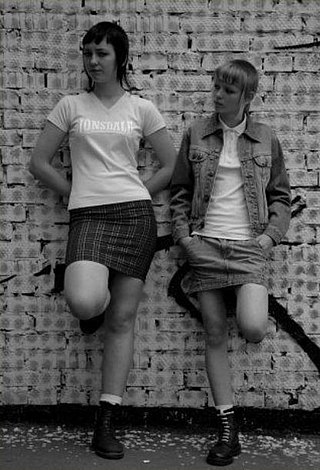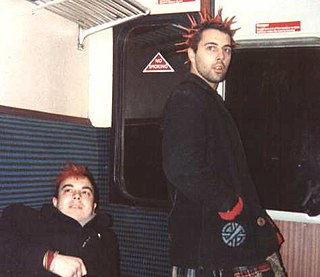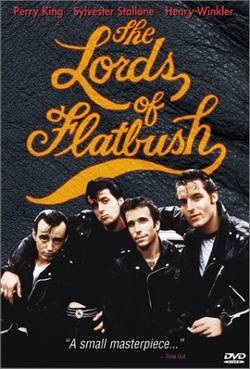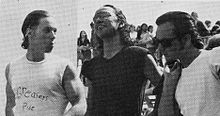
A skinhead or skin is a member of a subculture that originated among working-class youths in London, England, in the 1960s. It soon spread to other parts of the United Kingdom, with a second working-class skinhead movement emerging worldwide in the late 1970s. Motivated by social alienation and working-class solidarity, skinheads are defined by their close-cropped or shaven heads and working-class clothing such as Dr. Martens and steel toe work boots, braces, high rise and varying length straight-leg jeans, and button-down collar shirts, usually slim fitting in check or plain. The movement reached a peak at the end of the 1960s, experienced a revival in the 1980s, and, since then, has endured in multiple contexts worldwide.

Punk fashion is the clothing, hairstyles, cosmetics, jewellery, and body modifications of the punk counterculture. Punk fashion varies widely, ranging from Vivienne Westwood designs to styles modeled on bands like The Exploited to the dressed-down look of North American hardcore. The distinct social dress of other subcultures and art movements, including glam rock, skinheads, greasers, and mods have influenced punk fashion. Punk fashion has likewise influenced the styles of these groups, as well as those of popular culture. Many punks use clothing as a way of making a statement.
Greaser or Greasers may refer to:

Raggare is a subculture found mostly in Sweden and parts of Norway and Finland, and to a lesser extent in Denmark, Germany, and Austria. Raggare are related to the American greaser and rockabilly subcultures and are known for their love of hot rod cars and 1950s American pop culture. Loosely translated into English, the term is roughly equivalent to the American "greaser", English "rocker", and Australian "Bodgie" and "Widgie" culture; all share a common passion for mid-20th-century American cars, rockabilly-based music and related fashion.

Mod, from the word modernist, is a subculture that began in 1950s London and spread throughout Great Britain, eventually influencing fashions and trends in other countries. It continues today on a smaller scale. Focused on music and fashion, the subculture has its roots in a small group of stylish London-based young men and women in the late 1950s who were termed modernists because they listened to modern jazz. Elements of the mod subculture include fashion ; music and motor scooters. In the mid-1960s, the subculture listened to rock groups such as the Who and Small Faces. The original mod scene was associated with amphetamine-fuelled all-night jazz dancing at clubs.

Bōsōzoku is a Japanese youth subculture associated with customized motorcycles. The first appearance of these types of biker gangs was in the 1950s. Popularity climbed throughout the 1980s, peaking at an estimated 42,510 members in 1982. Their numbers dropped dramatically in the 2000s, with fewer than 7,297 members in 2012. Later in 2020 a Bōsōzoku rally that used to attract thousands of members only had 53 members, with police stating that it was a long time since they had to round up that many people.

Rockers are members or followers of a biker subculture that originated in the United Kingdom during the late 1950s and was popular in the 1960s. It was mainly centred on motorcycles and rock 'n' roll music. By 1965, the term greaser had also been introduced to Great Britain and, since then, the terms greaser and rocker have become synonymous within the British Isles, although used differently in North America and elsewhere. Rockers were also derisively known as Coffee Bar Cowboys. Their Japanese counterpart was called the Kaminari-Zoku.

The Teddy Boys or Teds were a mainly British youth subculture of the early 1950s to mid-1960s who were interested in rock and roll and R&B music, wearing clothes partly inspired by the styles worn by dandies in the Edwardian period, which Savile Row tailors had attempted to re-introduce in Britain after the Second World War.

The Lords of Flatbush is a 1974 American drama film directed by Martin Davidson and Stephen F. Verona. The film stars Sylvester Stallone, Perry King, Paul Mace, Henry Winkler, and Susan Blakely. Stallone was also credited with writing additional dialogue. The plot is about street teenagers in leather jackets from the Flatbush neighborhood of Brooklyn, New York. The movie, along with the television hit Happy Days, the musical Grease and its like-named film version, and novelty rock act “Sha Na Na’’, was part of a resurgence in popular interest in the '50s greaser culture in the 1970s.

Nozem was a term during the 1950s and 1960s to describe self-conscient, rebellious youth, often aggressive and considered problematic by authorities in the Netherlands. It was the earliest modern Dutch subculture, related to the Teddy Boy movement in the UK and the greasers in the United States. It was followed by the Provos.

Engineer boots, also known as engineer's boots or engineering boots, are an American type of traditional leather work-boots. Their lace-less, rugged construction made them popular among motorcycle riders. Originally developed in the 1930s for firemen working on steam locomotives, the boots gained substantial popularity in the post–World War II era during a growing motorcycling culture. They became popular symbols of teenage rebellion in the 1950s and a common component of greaser wear. They were later adopted by skinheads and punks in the 1970s. By the 2010s, engineer boots were being popularly worn for fashion purposes, especially by non-traditional customers such as women, young urban professionals, and hipsters.
Guido is a North American subculture, slang term, and ethnic slur referring to working-class urban Italian-Americans. The guido stereotype is multi-faceted. At one point, the term was used more generally as a disparaging term for Italians and people of Italian descent. More recently, it has come to refer to working-class urban Italian-Americans who conduct themselves in an overtly macho manner or belong to a particular working-class urban Italian-American subculture. The time period in which it obtained the later meaning is not clear, but some sources date it to the 1970s or 1980s. The term is not used in Italy.
Greaser was a derogatory term for a Mexican in what is now the U.S. Southwest in the 19th century. The slur likely derived from what was considered one of the lowliest occupations typically held by Mexicans, the greasing of the axles of wagons; they also greased animal hides that were taken to California where Mexicans loaded them onto clipper ships. It was in common usage among U.S. troops during the Mexican–American War.

Fashion of the 1960s featured a number of diverse trends, as part of a decade that broke many fashion traditions, adopted new cultures, and launched a new age of social movements. Around the middle of the decade, fashions arising from small pockets of young people in a few urban centers received large amounts of media publicity, and began to heavily influence both the haute couture of elite designers and the mass-market manufacturers. Examples include the mini skirt, culottes, go-go boots, and more experimental fashions, less often seen on the street, such as curved PVC dresses and other PVC clothes.

Workwear is clothing worn for work, especially work that involves manual labour. Often those employed within trade industries elect to be outfitted in workwear because it is built to provide durability and safety.
Bodgies and widgies refer to a youth subculture that existed in Australia and New Zealand in the 1950s, similar to the rocker culture in the UK or Greaser culture in the United States. Most bodgies rode motorbikes but some had cars, many of which were hotted-up with accessories such as mag wheels and hot dog mufflers. Males were called bodgies and females were called widgies.

The pompadour is a hairstyle named after Madame de Pompadour (1721–1764), a mistress of King Louis XV of France. Although there are numerous variations of the style for men, women, and children, the basic concept is having a large volume of hair swept upwards from the face and worn high over the forehead, and sometimes upswept around the sides and back as well.

Ivy League is a style of men's dress, popular during the late 1950s in the Northeastern United States, and said to have originated on college campuses, particularly those of the Ivy League. It was the predecessor to the preppy style of dress.

A leather jacket is a jacket-length coat that is usually worn on top of other apparel or item of clothing, and made from the tanned hide of various animal skins. The leather material is typically dyed black, or various shades of brown, but a wide range of colors is possible. Leather jackets can be designed for many purposes, and specific styles have been associated with subcultures such as greasers, motorcyclists, and bikers, mobsters, military aviators and music subcultures, who have worn the garment for protective or fashionable reasons, and occasionally to create a potentially intimidating appearance.

A scooterboy is a member of one of several scooter-related subcultures of the 1960s and later decades, alongside rude boys, mods and skinheads. The term is sometimes used as a catch-all designation for any scootering enthusiast who does not fall into the latter three categories.

















